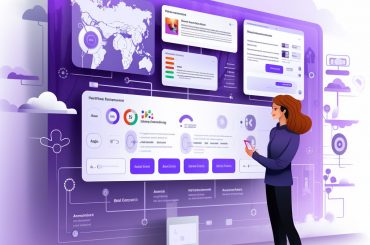Table of Contents
A significant advancement in the long-standing business process management is Digital Process Automation technology (DPA) (BPM). The key driver of this trend is the necessity for firms to swiftly automate activities as part of the digital transformation journey.
Leading companies are now concentrating on digitizing their procedures in order to be much more responsive and client-centric, both with the respect to how they respond to changing customer demands and launch new items onto the market.
A Comprehensive Overview Of Digital Process Automation DPA
Digital Process Automation (DPA), the logical follow-up to Business Process Management, is equally concerned with assuring the efficacy and efficiency of business operations but takes the concept further by concentrating on external users such as clients, suppliers, etc. This entails improving user interfaces and minimizing friction in your digital business processes. DPA’s fundamental principles include the following:
- First-to-mobile interfaces
- User access to transparent processes
- Automating client job completion
- Reminders and notifications that are triggered
- Simple cooperation
- User response and adaption in a hurry
So while digital automation and bpm software may have focused on getting the process right, Digital Process Automation assumes the process has been optimized and focuses on making the experience better.
What is Digital Process Automation (DPA)?
The term “Digital Process Automation” refers to a technique for automating processes and streamlining workflows using digital technologies. It focuses on automating activities like management, sales, and marketing that require human involvement. Better user experiences are the consequence as it extends the effectiveness of business process management (BPM) solutions to multiple stakeholders including clients, suppliers, and other stakeholders.
The following are some of the fundamentals of digital process automation:
- Preserving transparency throughout all processes
- Customer task automation
- Notification and reminder triggers
- Fostering a collaborative environment
Things SAP Digital Process Automation Can Automate
Digital process automation can be used for any process that includes a trigger, data gathering, information routing, and tracking.
- Triggers
There are two types of triggers: human and automated. Consider a request being made or an event happening in a CRM system.
- Data Gathering
In order to collect data, forms are frequently filled out, but information can also be automatically pulled out of or obtained from a system.
- Routing of Information
Business rules and logic which determine the next step in the data’s journey are involved when moving data between individuals or systems.
- Tracking
Processes can be audited and evaluated for performance by tracking what occurs during the whole course of a process.
Benefits Salesforce Digital Process Automation (DPA) Software brings to your organization
- Time Saver
You can free up your staff’s valuable time to work on more crucial core duties by automating hundreds and thousands of manually repetitive operations within your company.
- Cost Efficient
It costs a lot to hire people. When you automate procedures, you also increase staff productivity and help your firm save money, which can have a significant impact on the bottom line.
- Enhanced Accuracy
By removing circumstances where papers might be misplaced or procedures might be missing, digital process automation can improve process accuracy.
- Adaptability
Businesses are able to rapidly introduce and scale innovative solutions in response to market demands by utilizing digital process automation.
Digital Process Automation Examples
DPA is beneficial for the majority of company activities that involve direct human contact with clients or customers. They can be mechanized and digitalized to improve the user experience. Here are some instances of digital process automation in actual business contexts:
- Client Onboarding
Organizing pieces of training or orientations, processing paperwork, and other procedures are all necessary for manual onboarding. Customers may become impatient if the onboarding process is stretched out.
A corporate organization could use Digital Process Automation for customer service to automate the majority of the onboarding process processes in order to avoid this. It eliminates workflow bottlenecks and enables quicker and more effective transitions between each stage. Additionally, it guarantees that the information is always correct and current.
- Loan and Credit Approval
One of the corporate procedures that can considerably benefit from DPA is the approval of loans and credit. When done manually, gathering information and evaluating a client’s creditworthiness is a difficult operation that takes a lot of time and effort.
DPA streamlines and automates the loan process to guarantee increased effectiveness, accuracy, compliance, and prompt approval. Lending institutions can process more loan applications thanks to automated credit scoring, and they can monitor borrowers’ financial health through automated credit monitoring.
The clients of the lending institutions; such as Digital Process Automation for banks, also benefit from DPA’s advantages in loan and credit approval. Loan applications are handled more quickly and borrowers receive the finest offers available as the permitting process becomes more effective.
- Purchase Orders
Business organizations frequently deal with the repetitive and repeating operations of purchase orders. They frequently call for multiple permissions, which slows down work and reduces productivity. Transitions between permits could be accelerated with DPA. The Digital Process Automation for manufacturing automatically directs the request to the proper individuals after a purchase order has been submitted for approval. Additionally, it automatically alerts the person who made the request whenever a move is made. This greatly cuts down on the time lost going through modifications that would otherwise be done manually.
- Logistics
One of the industries with the most labor-intensive and time-intensive business operations is logistics. When carried out manually, repeated tasks like creating and collecting invoices, planning and monitoring shipments, obtaining proofs of delivery, and settling payment disputes all consume unneeded time. Additionally, they are vulnerable to mistakes and inadequacies that really can lead to significant losses.
These inefficiencies can be decreased and processes can be optimized with Digital Process Automation for field service to improve the client experience. DPA enhances order and shipment progress visibility in addition to streamlining workflows. In the end, it promotes business growth and fosters stronger client relationships.
All departments’ processes can be digitized in a wide range of ways. The procedures that DPA clients have migrated to the cloud are just a few of those listed below, giving both staff and customers a quicker, better, more uniform experience.
| IT/IS | Facilities | HR |
| IT Service Requests | Office Relocations | Benefits Changes |
| Security Access Requests | Resource Scheduling | Timesheets |
| New Account Setup | Facility Access | New Hire Management |
| Change Requests | Move Requests | Employee Onboarding |
| New Project Requests | Facility Access | Employee Offboarding |
| Security Incidents | Finance | Vacation Requests |
| Purchasing | CapEx/AFE Requests | Sales |
| Procurement Process | Expense Approvals | Quote Approvals |
| Capital Approvals | Salary/Wage Changes | Pricing Discounts |
| Vendor Management | AP Automation | Proposal Approvals |
| Invoice Approvals | Grant Management | Product Discounts |
| Product Pricing | Marketing | Legal |
| Operations | Campaign Approvals | Legal Holds |
| Complaint Management | Collateral Approvals | Contract Reviews |
| Maintenance Request | Brand Management | Client Intake |
| New Product Request |
Features You Want Look For While Getting Digital Process Automation Software
Tools for digital process automation (DPA) assist businesses in developing fully automated process solutions. You may easily create software to manage operations and digital workflow using the appropriate digital process automation solution.
Software that automates digital processes ought to be able to:
- Provide robot and automation abilities
- Add a measure of clever automation
- Offer functionality for application development and low-code process.
- Include a user-friendly, visually appealing interface that may be operated without any technical knowledge.
Conclusion
Organizations are given the flexibility and knowledge necessary by digital process automation to enable a comprehensive strategy for business process automation. It enables you to control the data flow throughout your organization, making it simpler to find areas for improvement and implement quick, agile changes—essential in today’s digital world.
The Digital Process Automation lowers expenses and frees up workers so they may focus on innovation rather than physical labor. Additionally, it combines IT and the business so that their objectives and course of action are perfectly in line, resulting in a far more agile organization.





